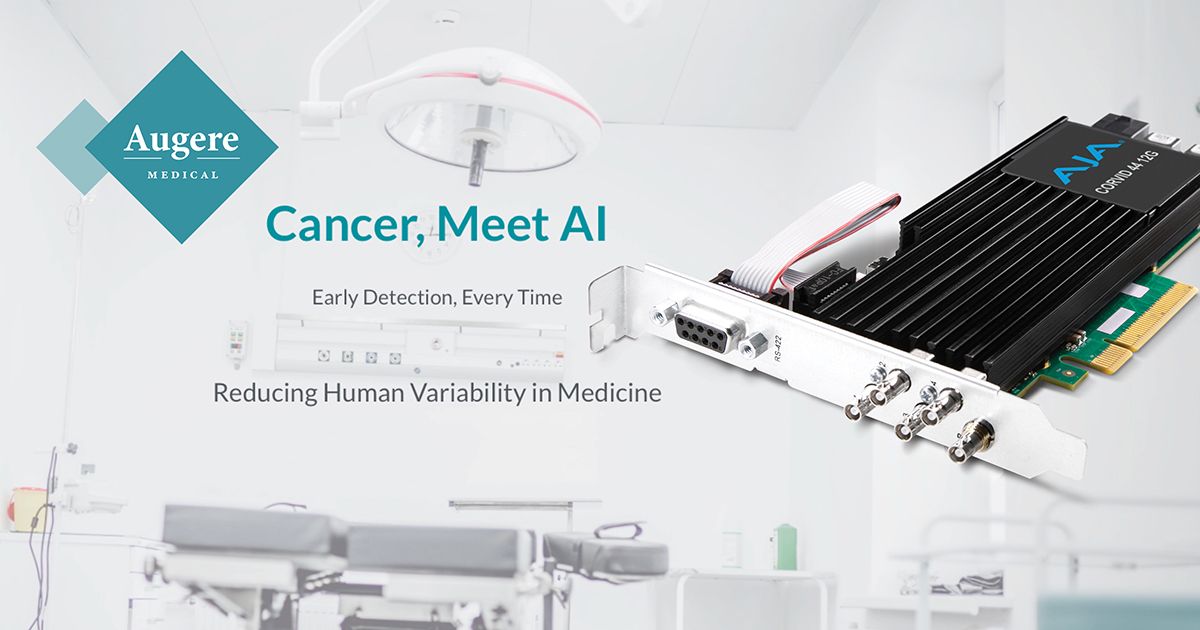Around every corner, artificial Intelligence (AI) is unlocking the unimaginable. When paired with live, high-quality video streaming, AI can help doctors identify cancer and other health risks early and with more accuracy than just the human eye. Recognizing this potential, Oslo-based medical technology startup Augere Medical developed an AI-driven analysis solution to improve the accuracy of colonoscopy findings, with 4K/HD video playback powered by an AJA Corvid 44 12G card.
The culmination of years of research by Augere Medical CEO Andreas Petlund and his team, the solution is currently undergoing regulatory approvals in Europe and the U.S. and is expected to make its way into procedure rooms by 2023. Petlund envisioned the technology to fill a healthcare niche he thought that multimedia data processing could fill. “Colorectal cancer claims almost a million lives each year; it’s one of the most expensive cancers to treat and often diagnosed late, which is why colonoscopies are a vital preventative measure," Petlund explained. "Early detection can make the difference between life and death, so by combining AI with proven multimedia technology, we’re able to help doctors better spot polyps or adenomas that could eventually turn fatal.”
[AJA Release New Firmware Update for openGear Cards]
Modern colonoscopy equipment and the pace at which the camera moves make it challenging for doctors to identify every problematic growth. Flat and sessile polyps, for instance, are especially hard to detect during colonoscopies, but machine learning has trained Augere’s solution to pinpoint these. The solution fuses a physical box, which connects to standard colonoscopy equipment and monitors, with proprietary AI video analysis software that powers the solution’s core functionality. Industry standard video hardware, including a PC with a few additional components, an NVIDIA Quadro RTX 4000 GPU card to support 50 video frames per second, and an AJA Corvid 44 12G I/O card for video playback, all play an important supporting role.
“Corvid was a natural choice for our solution; it is intuitive and can reliably pass through 4K and HD video without a signal break, and the SDK is solid,” explained Petlund. “Unlike other solutions on the market, Corvid’s SDK runs independently of our software running the video analysis. This ultimately ensures an added layer of security from an unexpected software failure that could freeze the entire solution and interrupt the procedure. Overall, it prevents the need to reboot the box during a colonoscopy and protects the patient from delayed examinations.
[Musion Produces Lifelike Interactive Holograms with AJA Gear]
“Corvid’s video pass-through functionality also allows us to overlay the colonoscopy video signal with the lowest possible amount of latency," he continued. "Even a 100-millisecond of added latency can impact the procedure negatively, so this is huge. Having the video pass through and the overlaid annotations and the decision support feedback on top of it ensures optimal performance and reduces latency for the doctors during the procedure.”
Facility AV needs vary depending upon the facility’s colonoscopy equipment, so Augere designed the solution to support both 4K and 1080p video. Video is passed from the colonoscopy camera through the box and into Augere’s software, which analyzes each frame. When the software flags a potential polyp, an alarm is activated on the box and a graphic laid over the area. The feed is also recorded so that physicians can review footage post-procedure and revisit areas of concern.
[AJA KONA Cards Bring Immersive Art Exhibits to Life]
For the immediate future, Augere remains focused on shepherding this solution through regulatory approvals and getting it into the hands of as many specialists as possible, but Petlund is also looking at how the core technology could be applied to other areas of video-based medical diagnostics, such as cystoscopy and laparoscopy.
“AI-driven video capture and analysis is one of the most groundbreaking developments in modern medicine," he concluded. "It’s allowing medical professionals and institutions to use and analyze multimedia data unlike ever before. We can now teach a machine to look for details that the human eye can’t always catch, which will be a huge asset in colorectal cancer prevention as well as in radiology, genetics, and other medical fields.”










